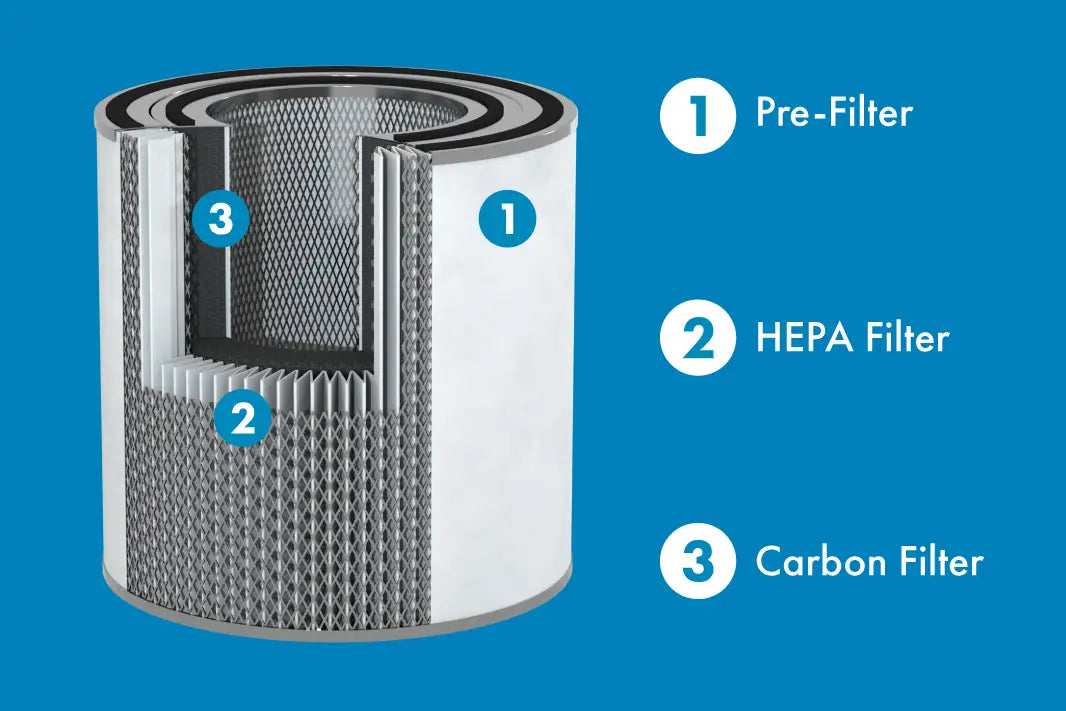What do our Air Purifiers remove from the air?

Air pollutants fall into 2 categories: particulate matter, and gases & chemicals. Our medical-grade air purifiers are specifically designed to remove these with different filter combinations available depending on your needs.
We offer the largest HEPA and activated carbon filters in the industry; the result is the only commercial grade air purifiers available for the home, which capture more particles and chemicals than any other air purifier.
Stage 1 | Technostat® Pre-filter
Stage 2 | H13 Medical-grade HEPA filter
Certified 99.97% minimum efficiency at 0.3 microns (tested down to 0.003 microns @ 100% efficiency) Our residential models offer a filter surface area ranging from 3.8m² on the E7 and E8 to an incredible 6.4m² on the E20 Plus and DE20 Plus models, each exceeding HEPA filtration standards.
What does the HEPA Filter remove?
| Bacteria | Viruses |
| Dust | Dust Mites |
| Aerosols | Allergens |
| Sub-Micron Particles | Pollens |
| Mould Spores | Pet Dander |
Stage 3 | Activated Carbon filter
Based on weight, INOVA includes more activated carbon in our filters than any other air purifier in Australia. Our INOVA-E8 system includes a 2.4kg Activated Carbon filter and we offer an even larger 6kg commercial-grade Activated Carbon filter in our INOVA-E20 and INOVA-DE20 models.
What Chemicals and Volatile Organic Compounds (VOC's) can Activated Carbon remove?
The Activated Carbon filter is designed to remove chemical pollutants, volatile organic compounds (VOC’s), smoke, road pollution and odours including;
| Acetaldehyde | Hydrogen iodide |
| Acetic Acid | Hydrogen selenide |
| Acetic anhydride | Hydrogen sulfide |
| Acetone | Incense |
| Acrolem | Indole |
| Acrylic Acid | Iodine |
| Acrylonitrile | Iodoform |
| Alcoholic Beverages | Irritants |
| Amines | Isophorone |
| Ammonia | Isoprene |
| Ameyl acetate | Isopropyl acetate |
| Amyl alcohol | Isopropyl alcohol |
| Amyl ether | Isopropyl ether |
| Aniline | Kerosene |
| Asphalt fumes | Kitchen odours |
| Automobile Exhaust | Lactic acid |
| Benzene | Menthol |
| Body odours | Mercaptans |
| Borane | Methil acetate |
| Bromine | Menthyl acrylate |
| Burned Flesh | Methyl alcohol |
| Burned Food | Methyl bromide |
| Butadiene | Methyl butyl ketone |
| Butane | Methyl cellosolve |
| Butanone | Methyl cellosolve acetate |
| Butyl acetate | Methyl chloride |
| Butyl alcohol | Methyl chloroform |
| Butyl cellosolve | Methyl ether |
| Butyl chloride | Methyl ethyl ketone |
| Butyl ether | Methyl formate |
| Butylene | Methyl isobutyl ketone |
| Butyne | Methyl mercaptan |
| Butyraldehyde | Methylcyclohexane |
| Butyric acid | Methylcyclohexanol |
| Camphor | Methylcyclohexaone |
| Caprylic acid | Methylene chloride |
| Carbolic acid | Monochlorobenzene |
| Carbon disulfide | Monofluorotri cloromethane |
| Carbon Monoxide | Naphtha |
| Carbon tetrachloride | Naphthziene |
| Cellosolve | Nitric acid |
| Cellosolve acetate | Nitro benzenes |
| Cheese | Nitroethane |
| Chlorine | Nitrogen dioxide |
| Chlorobenzene | Nitroglycerine |
| Chlorobutadiene | Nitromethane |
| Chloroform | Nitropropane |
| Chloronitropropane | Nitrotoluene |
| Chloropicrin | Nonane |
| Citrus and other fruits | Octalene |
| Cleaning compounds | Octane |
| Coal smoke | Onions |
| Creosote | Organic Chemicals |
| Cresol | Ozone |
| Crotonaldehyde | Packing house odours |
| Cychlohexane | Paint & redecorating odours |
| Cyclohexanol | Palmitic Acid |
| Cyclohexene | Paradichlorbenzine |
| Decane | Pantane |
| Dibromoethane | Pentanone |
| Dichlorobenzene | Pentylene |
| Dichlorodi fluoromethane | Pentyne |
| Dichloroethane | Perchloroethylene |
| Dichloroethylene | Perfumes, cosmetics |
| Dichloroethyl | Phenol |
| Dichloromono fluormethane | Phosgene |
| Dichloronitroethane | Pitch |
| Dichloroprpane | Poison gases |
| Dichloro tetrafluoroethane | Pollen |
| Diesel fumes | Poultry odours |
| Diethylamine | Propane |
| Diethyl ketone | Propionaldehyde |
| Dimethylaniline | Propionic acid |
| Dimethylsulfate | Propyl acetate |
| Dioxane | Propyl alcohol |
| Diproyl ketone | Propyl chloride |
| Ether | Propyl ether |
| Ethyl acetate | Propyl mercaptan |
| Ethyl acrylate | Propylene |
| Ethyl alcohol | Propyne |
| Ethyl amine | Putrefying substances |
| Ethyl benzene | Putrescine |
| Ethyl bromide | Pyridine |
| Ethyl chloride | Resins |
| Ethyl ether | Rubber |
| Ethyl formate | Sauerkraut |
| Ethyl mercaptan | Sewer odours |
| Ethyl silicate | Skalote |
| Ethylene chlorhydrin | Slaughtering odours |
| Ethylene dichloride | Smog |
| Ethylene oxide | Sour milks |
| Essential oils | Stoddard solvent |
| Eucalyptole | Styrene monomer |
| Fertilizer | Sulfur dioxide |
| Film processing odours | Sulfur trioxide |
| Fish odours | Sulfuric acid |
| Floral scents | Tetrachloroethane |
| Fluorotrichloro methane | Tetrachloroethylene |
| Formaldehyde | Tobacco smoke odour |
| Formic acid | Toilet odours |
| Gangrene | Toluene |
| Garlic | Toluidine |
| Gasoline | Trichlorethylene |
| Heptane | Trichloroethane |
| Heptylene | Turpentine |
| Hexane | Urea |
| Hexylene | Uric acid |
| Hexyne | Valeric acid |
| Hydrogen bromide | Valericaldehyde |
| Hydrogen chloride | Varnish fumes |
| Hydrogen cyanide | Xylene |
| Hydrogen fluoride |
* The list continues to grow as we discover and categorize new airborne chemicals.
